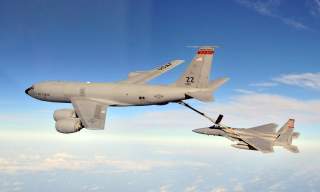The U.S. Air Force Could Transform Old Tankers Into New Command-and-Control Planes
The U.S. Air Force has a problem. The world’s leading air arm wants to reshape its force structure for a possible high-tech war with Russia or China. That means replacing many of the big, lumbering surveillance and command-and-control aircraft that the service relies on to direct forces during combat, but which also are increasingly vulnerable to enemy missiles. But replace them with what?
The U.S. Air Force has a problem. The world’s leading air arm wants to reshape its force structure for a possible high-tech war with Russia or China.
That means replacing many of the big, lumbering surveillance and command-and-control aircraft that the service relies on to direct forces during combat, but which also are increasingly vulnerable to enemy missiles.
But replace them with what?
Senior Air Force leaders have an idea. They proposed pairing the flying branch’s cutting-edge Advanced Battle Management System software with its huge fleet of aerial tankers, some of which are no less than 60 years old.
“We have to build a network force that supports then the ABMS architecture, that supports and is an element of overall [joint-service command and control],” Lt. Gen. Jon Thomas, the deputy commander of Air Mobility Command, told C4ISRNet reporter Valerie Insinna. “On a theater level, air mobility can significantly contribute to that, and I would say it starts with the tanker.”
The Advanced Battle Management System, which still is under development, is a complex suite of software that in theory would connect aircraft and other forces from across the U.S. military. Data would flow from satellites, drones and manned planes into and across the network, showing up as targeting icons on the cockpit displays in fighters, bombers and drone-control stations.
ABMS, if it works, first would replace the Air Force’s fleet of slightly more than a dozen E-8C radar-surveillance planes. The E-8s, which are based on unmodernized and underpowered Boeing 707 airframes, fly big, slow loops over a battlefield, spotting targets with their underslung radars and passing the data via radio link to other forces.
But the E-8s with their poor performance and huge signature on enemy sensor screens are among the most vulnerable aircraft in the Air Force inventory. The flying branch practically has begged Congress to let it retire the E-8s, but Congress has delayed retirement pending meaningful progress on ABMS.
Critics worry that the full ABMS suite won’t be ready until the 2030s. As happened with the E-8, which flew in Desert Storm in 1991 -- years before it officially was ready for combat -- it’s possible early versions of ABMS could be ready for front-line use in the 2020s.
Tankers could play a big role in supporting the new command-and-control network, Thomas told Insinna. “Tankers are well-suited to be used as communications nodes for two reasons, Thomas said. One, aerial refueling planes are typically large, wide-body aircraft that have enough excess space and power to host additional communication systems. The second is their location during combat. One way to operate tanker aircraft is to position them near a contested airspace, close enough for fighters and other airborne assets to refuel as needed before returning to battle, he said.”
“If you’re in that spot, you also have a great opportunity by virtue of that position,” Thomas commented. “You can communicate to a lot of different assets if you have the right equipment on the tanker. You can communicate line of sight to other air assets. You can communicate line of sight possibly to some assets on the surface.”
“If you have the ability to get to the space layer and communicate, then you can also be a pathway from line-of-sight to beyond line-of-sight, to the space layer,” Thomas added. “If you have a resilient space architecture, then you can lateral across and then come back down to a ground entry point.”
The new KC-46 tanker Boeing is building for the Air Force reportedly already has the power, space and communications infrastructure for ABMS. But the flying branch is buying only around 180 KC-46s to replace a portion of the roughly 500-strong fleet of KC-135 and KC-10 tankers dating from the 1960s and 1980s, respectively.
The KC-135s in particular could continue flying for many decades, so they too are candidates for ABMS radio-relay upgrades. Thomas noted that the Air Force has begun spending $1 million per plane to enhance the communications on 50 KC-135s. “We need to do more,” he told Insinna.
David Axe serves as Defense Editor of the National Interest. He is the author of the graphic novels War Fix, War Is Boring and Machete Squad.

